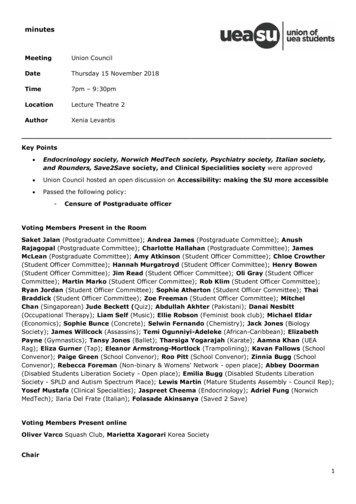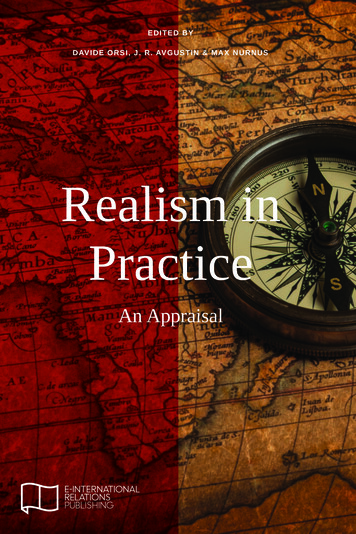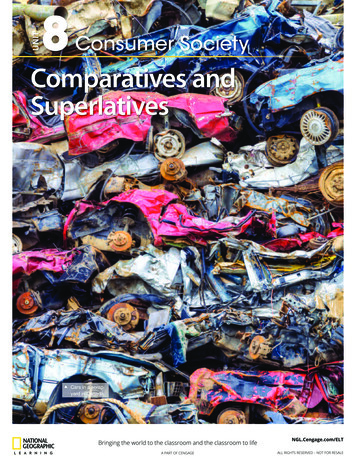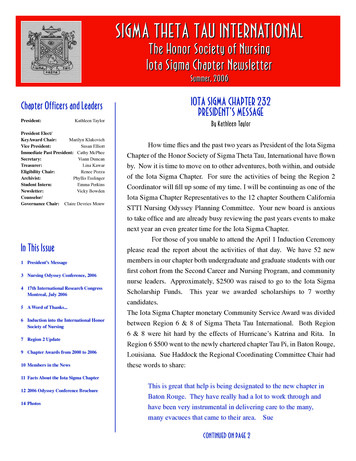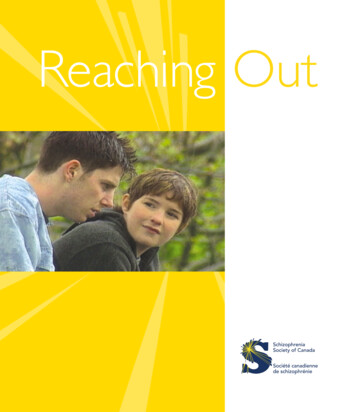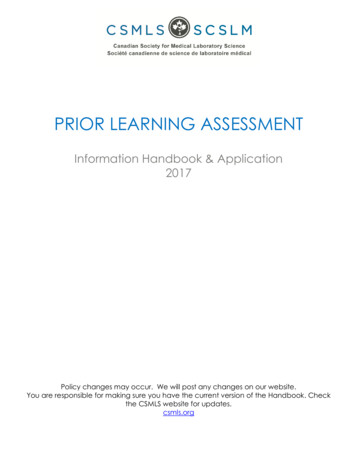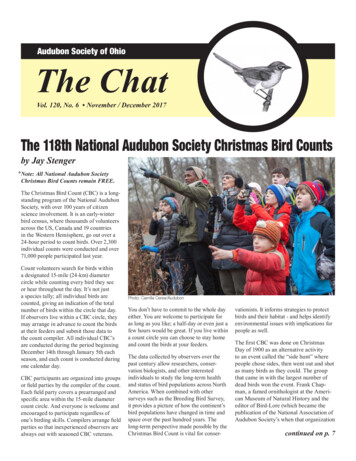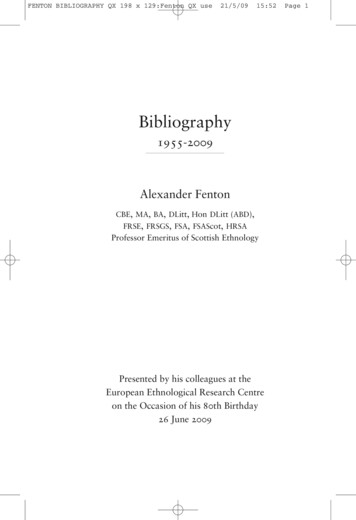
Transcription
FENTON BIBLIOGRAPHY QX 198 x 129:Fenton QX use21/5/0915:52Bibliography1955-2009Alexander FentonCBE, MA, BA, DLitt, Hon DLitt (ABD),FRSE, FRSGS, FSA, FSAScot, HRSAProfessor Emeritus of Scottish EthnologyPresented by his colleagues at theEuropean Ethnological Research Centreon the Occasion of his 80th Birthday26 June 2009Page 1
FENTON BIBLIOGRAPHY QX 198 x 129:Fenton QX use21/5/09Alexander Fenton on the occasion of his graduationfrom the University of Cambridge in 1953.15:52Page 2
FENTON BIBLIOGRAPHY QX 198 x 129:Fenton QX use21/5/0915:52Bibliography1955-2009Alexander FentonCBE, MA, BA, DLitt, Hon DLitt (ABD),FRSE, FRSGS, FSA, FSAScot, HRSAProfessor Emeritus of Scottish EthnologyForeword byMargaret A MackayEuropean Ethnological Research CentreCeltic and Scottish StudiesUniversity of Edinburgh27 George SquareEdinburgh EH8 9LDPage 3
FENTON BIBLIOGRAPHY QX 198 x 129:Fenton QX use21/5/0915:52Printed in Great Britainin 2009 byThe European EthnologicalResearch Centre,University of EdinburghThe right of The European EthnologicalResearch Centre to be identified as thecompiler of this book has been assertedby it in accordance with the Copyright,Designs and Patents Act 1988.Copyright European EthnologicalResearch Centre 2009The cover illustration shows PitglassieCroft, Auchterless, Alexander Fenton’schildhood home. Painted by May Beale,c1950.Images: as credited 2009No reproduction permitted withoutwritten permission to The EuropeanEthnological Research Centre in thefirst instance.No part of this publication may bereproduced, stored in a retrieval systemor transmitted, in any form or by anymeans, electronic, mechanical, photocopying, recording or otherwise, withoutthe prior permission of the publisher.Printed and bound in Great Britain byAthenaeum Press Ltd, Gateshead,Tyne & Wear.For a full listing of relatedtitles please visit:w w w.c elt sco t .e d. a c. u k/ E ERCPage 4
FENTON BIBLIOGRAPHY QX 198 x 129:Fenton QX use21/5/0915:52Page 5ContentsForewordby Margaret A Mackay7BibliographyPublications11-36Thematic ListAccount Books andFarmers’ DiariesArchivesBothy BalladsBuildings and HearthsCentral Direction andPopular ReactionChapbooksCultivationDomestic Crafts andHousehold EquipmentEthnological CartographyEthnological Theoryand PracticeFarm AnimalsFarm EquipmentFarming HistoryFarming LandscapeFarming VillagesFarmers’ ClubsFishing and the SeaFolk dForeign CountriesFuelGeneral StudiesGrazingHand Tools in FarmingHarvesting andGrain ProcessingIdentityInterpretationLexicographyand LanguageLiterary Piecesand TranslationsLocal andRegional StudiesManuringMaterial CultureMuseumsOral Traditionsand HistoryPlace NamesPoetry and 16263636464646565Editorial Activities67Biographical Details70
FENTON BIBLIOGRAPHY QX 198 x 129:Fenton QX use21/5/0915:52Drawing by Don Aldridge to illustrate a poem, ‘Daydreaming’,in If All the World Were a Blackbird.( Don Aldridge)Page 6
FENTON BIBLIOGRAPHY QX 198 x 129:Fenton QX use21/5/0915:52Page 7ForewordTHE European Ethnological Research Centre takes greatpleasure in publishing Professor Alexander Fenton’s Bibliography, prepared by his colleagues here to honour and celebrate an outstanding scholar, inspiring teacher and staunchfriend on the occasion of his eightieth birthday on 26 June2009.This list of nearly three hundred publications, arranged bothchronologically and thematically, not only provides an invaluable resource for all with an interest in European Ethnology andScotland’s place within it, but also, importantly, serves to charta career which exemplifies spheres of activity and methodological approaches which are all of a piece with the man himself. It reveals the contours of the personality which lies behindthe achievement and what he himself has called that ‘interestin folk and in their ways of doing and speaking’ which hasanimated his work from the start.The year 2009 sees several notable anniversaries: it is fiftyyears since Sandy, as he is known to all, was appointed to theNational Museum of Antiquities, following work as a lexicographer and editor on the Scottish National Dictionary; fortyyears since a visit to Slovakia confirmed sustained Europeaninvolvements; thirty-five years since he began to engage withuniversity teaching; twenty-five years since he created theReview of Scottish Culture; and twenty since the founding ofthe European Ethnological Research Centre, which now has7
FENTON BIBLIOGRAPHY QX 198 x 129:Fenton QX use21/5/0915:52its base in Celtic and Scottish Studies at the University ofEdinburgh, where he was appointed the first Professor ofScottish Ethnology.The biographical outline sketches in the highlights of SandyFenton’s career; the publications listed reveal the fruits of theendeavours of these years. A love of language and of poetry isa leitmotif throughout. (In fact, his first foray into print was apoem written while at King’s College, Aberdeen.) His ear wasattuned early to the Scots of home and neighbourhood and allthat it could convey in terms of rich regional variety. He wasencouraged by his teachers to acquire other languages and hedeveloped a facility in this regard. University study, NationalService in Germany, his post on the Scottish National Dictionary and subsequent museum work with its links to the Scandinavian open-air museum movement drew him to the ‘words andthings’ approach. The language of gesture, communication ‘withhands and feet’ through a knowledge of shared techniques andimplements, enabled him to communicate readily with thecountry people he encountered furth of Scotland on his ethnological travels and in the realm of cross-cultural comparison.Thus there is a strong international flavour to the scholarlyjournals and the languages in which his work has appeared.Indeed there is scarcely a country in Europe where his workhas not been published and highly regarded. And not infrequently his range of interests and abilities come delightfullytogether, as they do in the attractive volume If All the WorldWere a Blackbird, translations into Scots of another ‘Sandy’,the Hungarian poet Sándor Weöres, illustrated by his friendthe late Don Aldridge. Sandy has always felt that scholarshipshould be readily accessible to those who could identify closelywith it and see their own lives – or parallels to them – reflectedin it, so articles in local and popular publications, such as ‘APolish Baptismal Feast’ in the Turriff Advertiser, will be foundhere alongside those for the specialist.8Page 8
FENTON BIBLIOGRAPHY QX 198 x 129:Fenton QX use21/5/0915:52Page 9Here we find writing on food, on tools and processes, onterminology, on vernacular buildings (Sandy was instrumentalin forming The Scottish Vernacular Buildings Working Group),and on the development of ethnology as a subject. He has always been quick to acknowledge his mentors – among them thelate David Murison, Editor of the Scottish National Dictionary– and he too has been responsible for encouraging so many andfor bringing them into active ethnological work in museums,in universities and in projects such as those promoted by theEuropean Ethnological Research Centre, sustained by hisfriendship, kindliness, his interest in others, and the model ofhis writings.This Bibliography does not include a myriad of reports,reviews and other items produced over the years. Nor does theheading ‘Editorial Activities’ do full justice to the immense contribution this represents, from entries in the Scottish NationalDictionary to the co-editorship of the journal Tools and Tillage,and the general editorship role in the European EthnologicalResearch Centre of its Review of Scottish Culture, the Flashback series, Sources in Local History and the fourteen magisterial volumes of Scottish Life and Society: A Compendium ofScottish Ethnology. This bibliography will be ‘out of date’ soon,for Sandy continues to write and publish at a prodigious rateand a supplement will be required ere long.‘Ethnological wisdom inevitably begins at home’, he haswritten, and it is fitting that the cover illustration should be apicture of his home at Pitglassie Croft, Auchterless, painted byMay Beale around 1950. Home life has sustained him throughout his life, the one in which he was reared and the householdhe and Evelyn and their children created in Edinburgh. If amotto were to be selected for this volume, prepared withrespect and affection for a man in whom the personal and theprofessional interconnect so humanely, it could well comefrom his own simple yet eloquent words about ethnology, the9
FENTON BIBLIOGRAPHY QX 198 x 129:Fenton QX use21/5/0915:52discipline he has done so much to further through his research,his writing, his teaching and his example as lexicographer,museum curator and director, and university professor:It is an international subject, one perhaps that also borrows heavily from neighbouring disciplines, but equallyit is a subject that relates to each and every one of us, asindividuals within our own environments of home andwork, and there is no one who cannot be a practitioner.It is one in which personal roots, the home and environment within which the researcher is brought up, becomepart of the research apparatus of national identity.Margaret A MackayDIRECTOREuropean Ethnological Research CentreUniversity of Edinburgh10Page 10
FENTON BIBLIOGRAPHY QX 198 x 129:Fenton QX use21/5/0915:52Page 11BibliographyPUBLICATIONS19551. (with H M Shire) The sweepings of Parnassus: Fourpoems transcribed from the Record Books of the BurghSasines of Aberdeen, Aberdeen University Review,36:1, 43-52.19592. Proverbs and sayings of the Auchterless and Turriffarea of Aberdeenshire, Scottish Studies, 3, 39-71.3. An instrument used in twisting ropes, ScottishStudies, 3, 104-5.4. Some items from an Aberdeenshire parish, ScottishStudies, 3, 223-9.19615. Ropes and ropemaking in Scotland, Gwerin, 3,142-56 and 200-16.6. Sickles and scythes, The Scottish Young Farmer, 8:4.7. Stack foundations, The Scottish Young Farmer, 9:1.8. Stacks and tripods, The Scottish Young Farmer, 9:2.9. Scottish farm carts, Scotland’s Magazine, July.10. A museum of Scottish country life, ScottishAgriculture, Summer, 6-7.11
FENTON BIBLIOGRAPHY QX 198 x 129:Fenton QX use196221/5/0915:5211. The thatching and roping of stacks, The ScottishYoung Farmer, 9:4.12. Threshing with the flail, The Scottish YoungFarmer, 10:2.13. Scottish agricultural history museums, Transactionsof the Royal Highland and Agricultural Society ofScotland, 7, 1-9.14. (jointly with the School of Scottish Studies) TheRecording of Crofts and Houses: A Guide Questionnaire, Edinburgh, 18pp.15. Cheese-making, Scotland’s Magazine, June.16. Early and traditional cultivating implements inScotland, Proceedings of the Society of Antiquaries ofScotland, 96, 264-317.196317. Skene of Hallyard’s Manuscript ‘of Husbandrie’,Agricultural History Review, 11:2, 65-81.18. Grain drying kilns in Shetland, Shetland News,25 September.19. The threshers’ weary flingin’ tree, The ScottishYoung Farmer, 11:1.20. Threshing by hand, The Scottish Young Farmer,11:2.21. Threshing by machine, The Scottish Young Farmer,11:4.22. Scottish spinning wheels, Scotland’s Magazine,59:7, 117.23. The rural economy of East Lothian in the 17thand 18th century, Transactions of the East LothianAntiquarian and Field Naturalists’ Society, 9, 1-23.24. (with M F Michie), Cheese presses in Angus,Scottish Studies, 7, 47-56.12Page 12
FENTON BIBLIOGRAPHY QX 198 x 129:Fenton QX use196421/5/0915:52Page 1325. (with J J Laurenson), Peat in Fetlar, Folk Life, 2,3-26.26. The Chilcarroch plough, Scottish Studies, 8, 80-4.196527. Material culture as an aid to local history studies inScotland, Journal of the Folklore Institute, 2:3, 326-39.28. Hand tools in agriculture, Museum Assistants’Group Transactions, 5, 15-24.29. (with T C Smout), Scottish agriculture before theImprovers: An exploration, Agricultural HistoryReview, 13, 73-93.30. Farm servant life in the 17th-19th centuries,Scottish Agriculture, 46, 281-95.196631. The Begbie Farm Account Book 1729-70, Transactions of the East Lothian Antiquarian and FieldNaturalists’ Society, 10, 22-54.196732. Historical ethnology in Scotland, EthnologiaEuropaea, 1:1, 1-5.33. Die Volkskunst auf den Britischen Inseln: Schottland. In H J Hansen, ed. Europas Volkskunst und dieeuropaïsch beeinflusste Volkskunst Amerikas, Oldenburg and Hamburg.34. An approach to folk life studies, The KeystoneQuarterly, 12:1, 5-21.35. Das Bauernhaus auf Orkney und Shetland,Deutsches Jahrbuch für Volkskunde, 13:1, 50-68.196836. Alternating turf and stone: An obsolete buildingpractice, Folk Life, 6, 94-103.37. Scottish salmon fishing spears, The Salmon Net, 4,31-46.13
FENTON BIBLIOGRAPHY QX 198 x 129:Fenton QX use21/5/0915:5238. Plough and spade in Dumfries and Galloway,Transactions of the Dumfries and Galloway Antiquarian and Natural History Society, 45, 147-83.196939. Scottish salmon fishing spears, Transactions of theHawick Archaeological Society, 1969, 35-40.40. An early corn drier at Whittinghame Mains, EastLothian, Industrial Archaeology, 6:4, 388-91.41. A plough type from the Outer Isles of Scotland,Tools and Tillage, 1:2, 117-18.42. Sheep in North Ronaldsay, Orkney. In J G Jenkins,ed. Studies in Folk Life, London, 205-33.197043. Paring and burning and the cutting of turf and peatin Scotland. In A Gailey and A Fenton, eds. The Spadein Northern and Atlantic Europe, Belfast, 155-93.44. Clay building and clay thatch in Scotland, UlsterFolklife, 15-16, 28-51.45. Draught oxen in Britain, Rinderanschirrung(Národopisny Vĕstník Ĉeskoslovensky), 3-4, 17-53.46. The Plough-Sang: A Scottish source for Scottishplough history, Tools and Tillage, 1:3, 175-91.47. The Tabu language of Shetland fishermen, Ethnologia Europaea, 2-3, 118-22.48. Regional ethnology: A developing subject,Aberdeen University Review, 43:3, 261-7.197149. Hafer- und Gerstenmehl als Hauptgegenstand derschottischen Nahrungsforschung, Ethnologia Scandinavica, 1, 149-57.50. Planning a Scottish agricultural museum, ScottishSociety for Industrial Archaeology Newsletter, 3:2,11-12.14Page 14
FENTON BIBLIOGRAPHY QX 198 x 129:Fenton QX use21/5/0915:52Page 1551. The place of oatmeal in the diet of Scottish farmservants in the 18th and 19th centuries. In J Szabadfalviand Z Újváry, eds. Studia Ethnographica et Folkloristicain Honorem Béla Gunda, Debrecen, 87-101.52. A provisional note on ethnological food research inBritain, Ethnologia Europaea, 5, 53-54 (also in N-ABringéus and G Wiegelmann, eds. Ethnological FoodResearch in Europe and USA, Göttingen, 64-78).197253. The currach in Scotland, with notes on the floatingof timber, Scottish Studies, 16, 61-81.54. A fuel of necessity: Animal manure. In E Ennenand G Wiegelmann, eds. Festschrift Matthias Zender:Studien zu Volkskultur, Sprache und Landesgeschichte,2 vols, Bonn, II, 722-34.55. The Scottish Country Life Museums Trust,Museums Journal, 72:1, 7-8.56. Rural records, Scottish Home and Country, April,82.197357. The Various Names of Shetland, Edinburgh, 32pp.58. Craig-fishing in the Northern Isles of Scotland,Scottish Studies, 17, 71-80.59. The place of pork in the rural diet of Scotland. InW Escher, T Gantner and H Trumpy, eds. Festschrift fürRobert Wildhaber, Basel, 98-110.60. The Fourth International Conference on Ethnological Cartography, Stockholm, July 1972, EthnologiaScandinavica, 3, 144-7.61. Transport with pack horse and slide car in Scotland. In A Fenton, J Podolák and H Rasmussen, eds.Land Transport in Europe (Folkelivs Studier 4),Copenhagen, 121-71.15
FENTON BIBLIOGRAPHY QX 198 x 129:Fenton QX use21/5/0915:5262. Regional ethnology and environmental awareness,Museums Journal, 73:3, 107-10.63. The scope of regional ethnology, Folk Life, 11,5-14.64. Regional ethnology: Some recent books andjournals, Folk Life, 11, 88-92.65. The Scottish Country Life Museums Trust. InCountry Life Museums (Countryside Commission forScotland and Country Life Museums Trust), Perth, 2-6.197466. Early yoke types in Britain. In I Wellman, ed.Proceedings of the Hungarian Agricultural Museum,Budapest, 69-75.67. Sickle, scythe and reaping machine: Innovation patterns in Scotland, Ethnologia Europaea, 7:1, 35-47.68. Lexicography and historical interpretation.In G W S Barrow, ed. The Scottish Tradition, Edinburgh, 243-57.69. Scottish agriculture and the Union: An example ofindigenous development. In T Rae, ed. The Union of1707: Its Impact on Scotland, Glasgow, 75-93.70. Sowens in Scotland, Folk Life, 12, 41-7.71. The cas-chrom: A review of the Scottish evidence,Tools and Tillage, 2:3, 131-48.72. Wintertown és Shieling: Megjegyzések a skociaiTranszumánszról. In Tanyák (Magyar Néprajzi Társaságand Damjánich János Muzeum), Szolnok, 199-214.73. Seaweed manure in Scotland. In In MemoriamAntónio Jorge Dias, 3 vols (Instituto de Alta Cultura,Junta de Investigaço nes Cientificas do Ultramar),Lisboa, III, 147-86.74. Preface to I Balassa and G Ortutay, HungarianEthnography and Folklore, Budapest, 1974, 5-10.16Page 16
FENTON BIBLIOGRAPHY QX 198 x 129:Fenton QX use197521/5/0915:52Page 1775. European ethnology: Some recent books andjournals, Folk Life, 13, 90-7.76. Traditional elements in the diet of the NorthernIsles of Scotland, Ethnologische Nahrungsforschung.Ethnological Food Research (Kansatieteellinen Arkisto26), Helsinki, 64-78.197677. Scottish Country Life, Edinburgh, 255pp.78. Aspects of the North-East personality. In L Degh,H Glassie and F J Oinas, eds. Folklore Today:A Festschrift for Richard M Dorson, Bloomington,161-73.79. Studii di storia della cultura materiale in GranBretagna, con particolare riferimento alla Scozia,Quaderni Storici, 31, 54-67.80. Regional ethnology. In International Study Conference on the Role of Regional Ethnology in Environmental Interpretation and Education, Denmark, 11-15.81. Thatch and thatching. In A Fenton, B Walker andG Stell, eds. Building Construction in Scotland: SomeHistorical and Regional Aspects, Edinburgh, 39-51.82. The light and improved Scots plough and its team.In C O’Danachair, ed. Folk and Farm: Essays inHonour of A T Lucas, Dublin, 40-63.83. Translation (from Danish) of Steen Steensen Blicher,Diary of a Parish Clerk, Herning, 115pp.84. Translation of ‘Caritas Romana’. In G Lerche, ed.Axel Steensberg, 1st June, 1976, Caritas Romana, TheCommon Fields of Culture, Copenhagen, 9-36.197785. On the mapping of carts and wagons in Europe,Ethnologia Europaea, 9:1, 1-13.86. Scottish ethnology: The current position, MuseumEthnographers’ Group Newsletter, 4, 7-10.17
FENTON BIBLIOGRAPHY QX 198 x 129:Fenton QX use21/5/0915:5287. Domestic cattle in Scotland, The Ark, 3:3, 87-91.88. The Various Names of Shetland, reprint, Edinburgh,28pp.89. On the mapping of carts and wagons, Bericht überdie VI. Arbeitskonferenz der Organisationskommissionfür den Ethnologischen Atlas Europas und seiner Nachbarländer (19-24 September 1976, St Pölten, Austria),Wien, 34-7.90. Team cultivation with the spade in Scotland,Journal d’Agriculture Traditionelle et de BotaniqueAppliquée, 224:2-3, 77-86.197891. The Scottish Agricultural Museum, MuseumsJournal, 77:4, 167-8.92. The Island Blackhouse: A Guide to the Blackhouseat 42 Arnol, Lewis, Edinburgh, 55pp.93. The Northern Isles: Orkney and Shetland, Edinburgh, 719pp.94. Change and conservatism in the farm villages ofLewis. In Z Jasiewicz, ed. Tradycja i przemiana. Studianad Djiejami i Wspłczesna Kulturą Ludową, Poznań,125-36.95. Laudatory address for the Traditional AbingdonMorris Dancers, Europa-Preis für Volkskunst, Hamburg, 27-30.96. The interaction of drainage and farm equipment,Acta Museorum Agriculturae Pragae, 13:1, 92-6.197997. A Farming Township: Auchindrain, Argyll, Perth,20pp.98. A ploughshare from Argyll, Scotland, Tools andTillage, 3:4, 255-8.18Page 18
FENTON BIBLIOGRAPHY QX 198 x 129:Fenton QX use21/5/0915:52Page 1999. Continuity and Change in the Building Traditionof Northern Scotland (The Åsa G Wright MemorialLectures IV), Reykjavík, 19pp.100. Recent publications on vernacular building,Newsletter (Scottish Vernacular Buildings WorkingGroup), 5, 52-3.101. Domestic pigs and goats in Scotland, The Ark,6:8, 243-7.102. A note on Scottish straw rope granaries. In Ethnografcki i Folkloristichni Izsledvaniya (BulgarianAcademy of Sciences), Sofia, 144-9.1980103. Northern Links, Northern Studies, 16, 5-16.104. Books on vernacular building, Newsletter (ScottishVernacular Buildings Working Group), 6, 19-46.105. The traditional pastoral economy. In M L Parryand T B R Slater, eds. The Making of the ScottishCountryside, London and Montreal, 93-112.106. Hand threshing in Scotland, Acta EthnographicaAcademiae Scientiarum Hungaricae, 29:2-4, 349-89.107. Scottish Agricultural Museum, Interpretation,(Society for the Interpretation of Britain’s Heritage),5, 21-2.1981108. The Hearth in Scotland, Edinburgh, 39pp.109. Grain storage in underground pits, SubterraneaBritannica, 13, 12-15.110. (with B Walker), The Rural Architecture of Scotland, Edinburgh, 242pp.111. Early manuring techniques. In R Mercer, ed.Farming Practice in British Prehistory, Edinburgh,210-17.19
FENTON BIBLIOGRAPHY QX 198 x 129:Fenton QX use21/5/0915:52112. Albania: Some impressions, Omnigatherum,October, 2-4.113. Agriculture. In D Daiches, ed. A Companion toScottish Culture, London, 6-8.114. Interpretive approaches. In Interpretation: Understanding our Surroundings, Dublin, 2-8.115. Transport without wheels in northern Scotland. InA Paládi-Kovács, ed. Traditionelle Transportmethodenin Ostmitteleuropa, Budapest, 23-32.1982116. A Polish baptismal feast, Turriff Advertiser, 8January, 7.117. The longhouse in northern Scotland. In B Myhre,B Stoklund and P Gjærder, eds. Vestnordisk byggeskikkgjennom to tusen år. Tradisjon og forandring fra romertid til det 19. århundre (AmS Skrifter 7, Arkeologiskmuseum i Stavanger), Stavanger, 231-40.118. Net-drying, pot-drying and graddaning: Smallscale grain drying and processing techniques, Saga ochSed (Yearbook of the Royal Gustav Adolf Academy),85-106.119. Waulking the cloth. In A Gailey and D Ó hÓgáin,eds. Gold Under the Furze: Studies in Folk Tradition,Dublin, 129-37.1983120. Grain storage in pits: Experiment and fact. In AO’Connor and D V Clarke, eds. From the Stone Age tothe ‘Forty Five: Studies presented to R B K Stevenson,Edinburgh, 568-88.121. Laudatory address for Dr Zsuzsanna Erdélyi,Europa-Preis für Volkskunst, Hamburg, 9-12.20Page 20
FENTON BIBLIOGRAPHY QX 198 x 129:Fenton QX use198421/5/0915:52Page 21122. Notes on shellfish as food and bait in Scotland. InB Gunda, ed. The Fishing Culture of the World: Studiesin Ethnology, Cultural Ecology and Folklore, 2 vols,Budapest, I, 121-42.123. The Second Congress of the International Societyfor European Ethnology and Folklore, 30 September6 October 1982, Ethnologia Europaea, 13:2, 237-8.124. Developing the National Museum’s Country LifeArchive, Scottish Museum News, February-March, 2-3.125. The housing of agricultural workers in the nineteenth century. In T M Devine, ed. Farm Servants andLabour in Lowland Scotland, Edinburgh, 182-213.126. (with C Hendry) Wooden tumbler locks in Scotland and beyond, Review of Scottish Culture, 1, 11-28.127. Northern links: Continuity and change. In AFenton and H Pálsson, eds. The Northern and WesternIsles in the Viking World, Edinburgh, 129-46.128. Wheelless transport in northern Scotland. InA Fenton and G Stell, eds. Loads and Roads in Scotland and Beyond, Edinburgh, 105-23.129. The distribution of carts and wagons. In A Fentonand G Stell, eds. Loads and Roads in Scotland andBeyond, Edinburgh, 124-40.130. Administration of a national museum througha board of trustees. In J M A Thompson et al, eds.Manual of Curatorship: A Guide to Museum Practice,London, 516-17.1985131. The Shape of the Past: Essays in ScottishEthnology, 2 vols, Edinburgh, I 191pp, II 164pp.132. If All the World were a Blackbird (translationfrom Hungarian of S Weöres, Ha a Világ Rigó Lenne),Aberdeen, 104pp.21
FENTON BIBLIOGRAPHY QX 198 x 129:Fenton QX use21/5/0915:52133. 20,000 prayers for Rozália Bábos, AberdeenUniversity Review, 51:2, 215-18.134. The Sixth International Ethnological FoodResearch Conference, Ethnologia Europaea, 15:2,182-4.135. Building tradition in Shetland: The vernacularevidence. In B Smith, ed. Shetland Archaeology, Lerwick, 159-74.136. Bread baking by the Herold family, in Dunabogdány, Hungary, Petits Propos Culinaires, 22, 75-6.1986137. Laudatory address for the folk dance group ofVranisht-Terbaç, Albania, Europa-Preis für Volkskunst,Hamburg, 7-19.138. Food and the coastal environment. In A Fentonand E Kisbán, eds. Food in Change, Edinburgh, 122-5.139. Food on Sunday, Review of Scottish Culture, 2,53-7.140. Sonntagsessen. In A V Hansel, M Kundegraberand O Moser, eds. Tradition und Entfaltung: Volkskundliche Studien (in Memoriam Hanns Koren),Trautenfels, 265-71.141. The position of ethnology in Britain: Academicand museum activity, Ethnos (Kansatiede NeljässäMaanosassa), 10, 17-39.1987142. North East Farming Life: A Companion to theExhibition ‘Weel Vrocht Grun’ (North East of ScotlandAgricultural Heritage Centre), Macduff, 24pp.143. Northeast farm diaries, Heirskip (The BuchanHeritage Society), 87, 15-16.144. Wirds an’ wark ‘e seasons roon on an Aberdeenshire Farm, Aberdeen, 84pp.22Page 22
FENTON BIBLIOGRAPHY QX 198 x 129:Fenton QX use21/5/0915:52Page 23145. Traditional buildings. In D Omond, ed. TheGrampian Book, Golspie, 259-66.146. A Northeast farmer’s working vocabulary. In CMacafee and I Macleod, eds. The Nuttis Schell: Essayson the Scots Language, Aberdeen, 153-65.147. Government action and popular reaction:A twentieth century episode in the northeast of Scotland. In N-A Bringéus, U Meiners, R-E Mohrmann, DSauermann and H Siuts, eds. Wandel der Volkskultur inEuropa (Beiträge zur Volkskultur in Nordwestdeutschland 60, 1-11), 2 vols, Münster, I, 89-103.148. Twenty years of the Scottish Vernacular BuildingsWorking Group, Vernacular Building, 2, 2-5.149. Country Life in Scotland: Our Rural Past, Edinburgh, 194pp.1988150. Industrial heritage and contemporary documentation: Considerations from Norway, Museums Journal,88:2, 81-3.151. Sequences in the preservation of milk products inScotland. In A Riddersvold and A Ropeid, eds. FoodConservation: Ethnological Studies, London, 195-9.152. Pigs and mugs. In A Fenton and J Myrdal, eds.Food and Drink and Travelling Accessories: Essays inHonour of Gösta Berg, Edinburgh, 38-49.153. Population statistics, Lallans, 30, 12.154. A farm cash book from Glenesk in Angus,1885-1898, Journal of the Edinburgh AgriculturalAssociation, 62, 10-16.155. Popular culture and the Turra Coo. In G Cruickshank, ed. A Sense of Place: Studies in Scottish LocalHistory, Edinburgh, 76-86.23
FENTON BIBLIOGRAPHY QX 198 x 129:Fenton QX use21/5/0915:52156. Farmers’ diaries and their interpretation. InA Gailey, ed. The Use of Tradition: Essays presented toG B Thompson, Holywood, 123-30.157. (with D Kidd, E Langler and C Hendry), TheScottish Ethnological Archive (National Museums ofScotland), Edinburgh, 17pp.1989158. The Island Blackhouse, 2nd edn, Edinburgh, 44pp.159. Workers in a lost landscape, Weekend Scotsman,30 September, 1-3.160. Laudatory address for the Brabants Volksorkest,Leuven, Belgium, Europa-Preis für Volkskunst, Hamburg, 13-14.161. Farming Scotland’s cold shoulder, Discover Scotland, 6, 154-5.162. Essential evidence: The material culture ofScotland. In J Calder, ed. The Wealth of a Nation inthe National Museums of Scotland, Edinburgh andGlasgow, 19-42.163. The Turra Coo: A legal episode in the popularculture of north-east Scotland, Aberdeen, 84pp.164. Scottish Country Life [pictures], Edinburgh, 96pp.165. Wheeled vehicles for loads: Pre-Improvementtypes and terminology in Scotland. In F O Baptista,J Pais de Brito, M L Braga and B Pereira, eds. Estudosem Homenagem a Ernesto Veiga de Oliveira, 3 vols(Instituto Nacional de Investigaçâo Cientifica, Centrodo Estudos de Etnologia), Lisbon, III, 149-66.166. The hearth as a marker of social change: TheScottish example. In B Gunda, L Lukács and A PaládiKovács, eds. Ideen, Objekte und Lebensformen:Gedenkschrift für Zsigmond Bátky, Székesfehérvár,65-75.24Page 24
FENTON BIBLIOGRAPHY QX 198 x 129:Fenton QX use21/5/0915:52Page 25167. Foreword to Highland Vernacular Building(Scottish Vernacular Buildings Working Group),Edinburgh, 5-6.168. The position of ethnology in Britain: Academicand museum activity. In L Dziegiel and A SmabrzychkaKunachowics, eds. Problemy Metodoligicne Etnografii(Polska Akademia Nauk-Oddział w Krakowie, KomisjaEtnograficzna), Kraków, 129-49.169. The working vocabulary of a farm in northeastScotland in the mid twentieth century. In J L Mackenzieand R Todd, eds. In Other Words: Transcultural Studiesin Philosophy, Translation and Lexicology presented toHans Heinrich Meier on the occasion of his sixty-fifthbirthday, Dordrecht, 315-25.170. Tools and tillage in northern Scotland. In J SSmith and D Stevenson, eds. Fermfolk and Fisherfolk,Aberdeen, 83-101.1990171. The Turra Coo, Discover Scotland, Part 12, 315.172. The Horseman’s Word, Discover Scotland, Part 16,983.173. The Scottish bondager, Discover Scotland, Part 30,817.174. The droving trade, Discover Scotland, Part 33,922-3.175. Turf and peat, Discover Scotland, Part 39, 1067.176. Shetland hooses, Discover Scotland, Part 39,1079.177. Agriculture in Edinburgh, Discover Scotland, Part50, 1377.178. On Your Bike: Thirteen Years of TravellingCurators, Edinburgh, 28pp.25
FENTON BIBLIOGRAPHY QX 198 x 129:Fenton QX use21/5/0915:52179. The people below: Dougal Graham’s chapbooksas a mirror of the lower classes in eighteenth centuryScotland. In A Gardner-Medwyn and J Hadley Williams,eds. A Day Estivall: Essays on the Music, Poetry andHistory of Scotland and England and Poems previouslyunpublished, Aberdeen, 69-80.180. Introduction to I MacLeod
FENTON BIBLIOGRAPHY QX 198 x 129:Fenton QX use 21/5/09 15:52 Page 10. PUBLICATIONS 1955 1. (with H M Shire) The sweepings of Parnassus: Four . Scottish farm carts, Scotland's Magazine, July. 10 . A museum of Scottish country life, Scottish Agriculture, Summer, 6-7. 11 Bibliography
